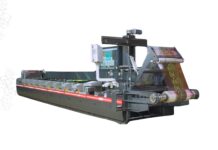Correspondent Priyanka Tanwar recently had a conversation with VK Seth, managing director of Sakata Inx India, on its bouquet of products for the packaging printing industry in India, and the demand for sustainable and environmentally safe inks.
Packaging South Asia (PSA) – What kind of inks do you supply to the flexible packaging, folding carton, and corrugated industry in India?
VK Seth – Sakata Inx India is not catering to the carton printing and corrugation printing market yet. We are in flexible packaging, both gravure, and flexo. We have a large range of inks from reverse printing to surface printing of flexible films and laminates, to labels, and to food grain packaging – basically for all types of applications. We have a very large share as far as the liquid inks for the flexible packaging market are concerned.
PSA – Where are these inks manufactured?
VK Seth – In India, we have two plants. One is in Bhiwadi, which is about 45 kilometers from Gurugram, and the second one is in Panoli, which is about 10 kilometers from Ankleshwar in Gujarat. Our third plant in the subcontinent, which is also a 100% subsidiary of Sakata India, and it just commenced commercial production in November 2021 in Bangladesh. About 30 kilometers from Dhaka, it has come into full steam and is catering to the Bangladesh market.
PSA – How has the Covid-19 pandemic affected the demand for packaging and food-grade inks?
VK Seth – Volumes definitely have shrunk. It looks like that the job losses, which happened due to the Covid-19 pandemic, and the earning power, which has gone down, have impacted the consumption of FMCG goods. Our reading is that the current volumes are at the level of FY 2018-2019, which is pre-Covid. In between, the volumes have been just washed off. I mean, this market was growing at the rate of 10 to 12% per annum, but somehow this Covid period is a kind of washout in terms of volumes. Thus a shrinkage of volumes has happened and we only hope that as the economy gets better, the ink segment should regain its past growth trajectory.
PSA – What kind of substrates are your packaging inks compatible with?
VK Seth – We have a very large portfolio. We have inks that are toluene-free, we have inks for surface printing, and we have some universal inks that can print on all types of substrates from polyester to BOPP, nylon, foil, and paper. You name a substrate, and we can print it with the kind of applications that the customer requires. All types of substrates can be printed with our inks.
PSA – What is your approach towards sustainability?
VK Seth – Sakata is very highly focused on sustainability and as our first step in India, we have already started measuring our carbon footprint and greenhouse gases. We are ahead of the curve as specified by the Government of India, as of yesterday, that they want the industry to reduce its carbon footprint by 40-45%.
Sakata India has already taken steps where we are ahead of compliance with the COP26 agreement benchmarks. We have taken a very massive exercise in the company to measure stage I, stage II, and stage III emissions and energy consumption. In stage I and stage II, we are well ahead of the curve, but in stage III we are working with some consultants to actually first measure our carbon footprint and then we will take certain actions on it.
PSA – Would you like to comment on the single-use plastic ban that come into force recently?
VK Seth – This is a very good step. This will help the environment to a large extent, but still, there are many things that our government and our municipalities need to do. The primary thing is to collect and recycle. Banning is a temporary process, a step, but in the long run, governments and municipalities, and people, by and large, should be able to segregate and recycle and help to recycle. Those types of investments need to be brought in and technologies need to be brought in by the country to make plastic-based packaging more sustainable and usable by the economy.
PSA – What are some innovations Sakata has experimented with in the past few years?
VK Seth – As I said, we have inks that are toluene-free, and we have inks that are even vinyl-free. This is a unique kind of requirement. However, companies such as Nestle have started asking for such products. Sakata is ready for such products.
We have been able to produce inks that are mineral oil-free, which are more environmentally safe and can be easily recycled. Our target focus is on human safety, environment safety, and the SDG goals. The parent company, Sakata Japan, is driving this initiative in all its subsidiaries and Sakata India, is sincerely focused on this.
PSA – Would you like to talk about your expansion plans?
VK Seth – We have just put up a plant in Bangladesh, which is a very large liquid ink production facility. We are investing in UV technologies, which Sakata India will be producing in our Panoli plant in Ankleshwar for the first time in India. And that plant is under construction and should be up and running by the end of this year.
PSA – Would you like to add something from your side?
VK Seth – The concerns today are the environment and safety. This is our prime focus, but it has to be backed up by some sort of strong legislation and motivation by the government to invest in certain technologies. And all stakeholders must get into this together because in isolation and in pockets, such initiatives are difficult to implement.











